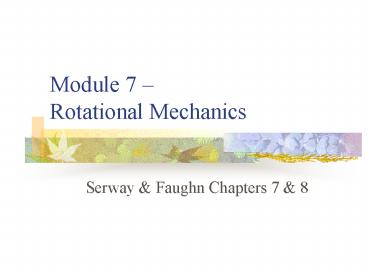Module 7 Rotational Mechanics PowerPoint PPT Presentation
1 / 40
Title: Module 7 Rotational Mechanics
1
Module 7 Rotational Mechanics
- Serway Faughn Chapters 7 8
2
Module Study Objectives
- Circular motion (revisited)
- Law of gravity
- Torque
- Centre of gravity
- Rotational kinetic energy
- Angular momentum
3
Angular Measure
4
Angular Speed
5
Example
- A helicopter rotor has an angular speed of 320
rpm. What is this in radians per second?
6
Angular Acceleration
7
Rotation Under Constant Angular Acceleration
8
Example
- A bicycle wheel experiences angular acceleration
of 3.5 rad/s2. If the initial angular speed is
2.0 rad/s, through what angle does the wheel
rotate in 2.0s and what is its speed?
9
Relations Between Angular and Linear Quantities
10
Example
- A computer floppy discs rotates from rest to 31.4
rad/s in 0.892s. How many rotations does it make
coming up to speed?
11
Example
- A CD is read with constant linear speed of 1.3
m/s. What angular speeds are needed at radii of
5.0 8.0cm and how long a track is needed for 1
hour of play?
12
Centripetal Acceleration
- In circular motionthe centripetal acceleration
is directed inward toward the centre of the
circle and has a magnitude given by either v2/r
or r?2.
13
Example
- A test car moves at 10 m/s around a circular road
of radius 50m. Find centripetal acceleration and
angular speed.
14
Centripetal Forces
- Tension
- Gravity
- Friction
v
m
F
r
15
Problem-solving Strategy Centripetal Forces
- Draw a diagram
- Choose coordinate system
- Find the net force towards the centre
- Solve using Fma
16
Example
- A car travels 13.4 m/s on a level circular turn,
radius 50.0m. What minimum coefficient of static
friction between tyres and road is needed to
prevent sliding?
17
Rotating Systems
- Centrifugal force is based on an erroneous
understanding of motion in an accelerated
reference frame. Objects are merely obeying
Newtons first law.
18
Example
- What speed must a roller coaster car have at the
bottom of a loop of radius 10m to reach the top?
19
Newtons Law of Gravity
- Every particle in the universe attracts every
other particle with a force that is directly
proportional to the product of their masses and
inversely proportional to the square of the
distance between them
20
Features of Gravitation
- Gravity is a field force independent of the
medium separating bodies. - Force decreases rapidly with distance.
- Proportional to the product of the masses.
- Force exerted by a spherical mass on an outside
particle acts as if all the mass is at the
centre.
21
Dark Matter
- Star and galaxy motion indicate much more
gravitating matter than is visible.
Orbiting galaxy
Massive galaxy dark matter halo
22
Example
- Use the law of gravity to estimate the Earths
mass.
23
Gravitational Potential Energy
- Newtons law provides an exact expression for
potential energy. - mgh is a good approximation near the earths
surface.
24
Escape Speed
- An object requires an escape speed to leave the
Earth or some other gravitating body - This speed is 11 km/s for any object (eg gas
molecule) to leave the Earth
25
Keplers Laws
- All planets move in elliptical orbits with the
Sun at one of the focal points. - A line drawn from the Sun to any planet sweeps
out equal areas in equal time intervals. - The square of the orbital period of any planet is
proportional to the cube of the average distance
from the planet to the Sun.
26
Torque
- The tendency of a force to rotate a body about
some axis is measured by the quantity called the
torque.
d
hinge
F
27
Example
- What is the torque produced by a 300-N force
applied at 600 to the door?
d2.0m
600
hinge
F
28
Torque Equilibrium
- A system is in static equilibrium if
- Resultant external force is zero
- Resultant external torque is zero
29
Centre of Gravity
- The centre of gravity is where all the mass of
the body can be considered to be concentrated.
THIS END UP
CoG
30
Problem-solving for Objects in Equilibrium
- Draw a diagram
- Show all the force vectors
- Establish a co-ordinate system
- Apply 2nd equilibrium condition (no net torque)
- Apply 1st condition (no net force) solve
simultaneous equations
31
Example
- Determine where the second mass should be for
static equilibrium.
500N
350N
x
1.5m
32
Force and Torque
- The torque for a mass in circular motion about a
point leads to an expression similar to that of
force.
33
Moment of Inertia
- Rotational mechanics analogue of mass.
- Need to sum all contributions with respect to a
specific rotational axis.
34
Torque Angular Acceleration
- In general, the total torque on a rigid body
rotating about a fixed axis is given by moment of
inertia times angular acceleration.
35
Rotational Kinetic Energy
- A body rotating about some axis with an angular
speed has kinetic energy that depends on its
moment of inertia
36
Angular Momentum
- Product of moment of inertia times angular
velocity.
37
Angular Momentum Torque
- Angular momentum is conserved when the net
external torque acting is zero.
38
Problem-solving for Rotational Motion
- Steps analogous to linear motion strategy
- Analogous equations (eg ?? I? instead of ?Fma)
39
Example
- In a supernova explosion, a star collapses from
radius 106 km to a pulsar of radius 10km
(such events do occur). Assume mass and angular
momentum are preserved. If the star rotated about
once a fortnight (106s), how fast does the pulsar
spin?
40
End of Module
- Any questions?

